Princess Padmaraje Chhatrapati - An Incomplete Royal Destiny, Part 1.
Written by : Amita Roy
Dated: July 29,2019
Share
.png)
Princess Padmaraje Chhatrapati as a toddler with her mother, Senior Maharani of Kolhapur, Tarabai Chhatrapati in 1941 and step mother Junior Maharani Vijaymala Chhatrapati.
It was a fine humid morning, like any other day of March in Kolhapur in 1940, that an intimation reached the office of the British Resident of Kolhapur, that Senior Maharani of Kolhapur and wife of the then Maharaja of Kolhapur, Sir Rajaram Chhatrapati was pregnant for the first time after 22 years of long marriage. The news was important as it will decide the fate and future of the Kolhapur throne, one of the most important princely states in India, and the torch bearer of Chhatrapati Shivaji Maharaj’s direct legacy, other than the Satara.
.png)
Maharaja of Kolhapur Rajaram Chhatrapati
Maharaja Sir Rajaram Chhatrapati, the oldest son of Maharaja of Kolhapur, Shahu Chhatrapati, by his first wife, Maharani Lakshmibai Sahib Chhatrapati, was born in 1897, and inherited the Kolhapur throne, by the virtue of birth, in 1922. He married first, Princess Indumati Gaekwar, daughter of Yuvraj Fatehsinh Gaekwar and granddaughter of Maharaja of Baroda, Sayajirao Gaekwar in 1918, who was rechristened as Maharani Tarabai Chhatrapati. Later in 1925, he remarried Maharani Vijaymalabai Sahib Chhatrapati, nee Mohite, who was originally from Tanjore in Tamilnadu. Till the early part of 1940, there was no confirmation of birth of any child from both of the Maharanis of Kolhapur.
.png)
Press coverage internationally about the death of Maharaja Rajaram Chhatrapati in 1940.
On 5th October 1940, the much-anticipated day for which everyone in the state of Kolhapur was waiting, arrived with the most important news, the birth of scion for the future of the throne of Kolhapur. Well, the news received a mixed bag of reactions. While the Kolhapur Darbar and the general public of Kolhapur was eagerly waiting to get the news of the birth of a son, but destiny disappointed them. The scion born was a daughter, and also the first child of Maharaja Rajaram Chhatrapati, who also went on to become the only biological child of the Maharaja.
Maharaja Rajaram Chhatrapati who ruled from 1922, was largely known as a Reformer Maharaja. He introduced a lot of reforms for the advancement and comfort of his subjects, especially his sympathy towards higher education of females and the establishment of further academic infrastructure was well known. Naturally, he was over joyed by the birth of his only biological child, Princess Padmaraje. But fate and luck had some other plans. When the Maharaja had just started enjoying his role as a father very late in life, suddenly on 26th November 1940, he expired in his residence ‘Shivtirth’ in Bombay due to heart attack. Maharaja Rajaram Chhatrapati was also well known as India’s foremost race horse owner, enjoying an annual revenue 5 million USD and a population over 10 lakhs of people.
(1).png)
Maharani Tarabai Chhatrapati with daughter Princess Padmaraje Chhatrapati
Now the unexpected sudden death of Maharaja Rajaram Chhatrapati opened up some further unexpected and unanswered situations and questions regarding who will become the next heir to the Kolhapur Gadi or throne. Maharaja Rajaram Chhatrapati was a biological heir due to law of primogeniture and had inherited the throne directly from his biological father. Hence, Kolhapur who already had a prolonged history of adoptions when it came to selection of heir to the Kolhapur throne, was not applicable on Rajaram Chhatrapati. But the Maharaja leaving the throne without any biological male heir or adopted, the question of adoption again rose its head, a topic which was dormant for some decades in the history of Kolhapur. The only immediate relatives who survived Maharaja Rajaram Chhatrapati, were his both the widows and his only biological child. But he also left an extended family, which consisted of his mother Maharani Lakshmibai Chhatrapati and his older sister, Maharani of Dewas Senior, Radhabai Puar who was famously known as Akkasaheb and her son Maharaja of Dewas Senior, Vikramsinh Rao ‘Nanasahib’ Puar. From this point, the history of the princely state of Kolhapur witnesses a series of roller coaster events and situations, circumstances which continued till 1954 when Senior Maharani Tarabai Chhatrapati expired. We will observe and study this period into 2 phases or parts; from 1940 to 1942 and from 1943 to 1954. Let’s unfold the journey of events which represents the aftermath of the death of Maharaja Rajaram Chhatrapati.
In the month of December 1940, there was a meeting between Maharani Lakshmibai Chhatrapati with the then British Resident of Kolhapur, Col. P. Gaisford. The meeting was held to ask the opinion of Maharani Lakshmibai Chhatrapati about the heir to Kolhapur throne. From this point, a series of correspondence started between the royal ladies of Kolhapur Princely State Zenana and the higher authorities of the British Indian Government which continued till 1942, whose core essence was the topic of adoption.
Flashback to 1760, when the first adoption to select the future heir of Kolhapur throne happened. In the subsequent years like in 1866, 1870, 1884, further adoptions to chose the heir to Kolhapur throne can be seen. But what was the ground or criteria for selection of the future Chhatrapati of Kolhapur? In 1760 and 1870, adoption of heir to the throne was done from a collateral branch belonging essentially to the Bhonsle clan especially from Chaurekar Khanvatkar branch. But the adoptions that happened in 1866 and 1884 were a bit different. The heir was chosen from the late ruler’s sister’s line of descendants. For eg. In 1866 Shivaji IV adopted his sister’s son. In 1884, grandson of another sister, of Kagal Senior family, of the same ruler was adopted. Hence a pattern for adoption can be observed.
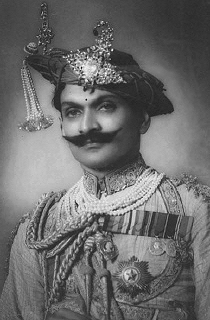
Maharaja of Dewas Senior, Vikramsinhrao Puar.
Coming back to the correspondence that happened between the Kolhapur royal ladies and the British Government, both the parties put their best feet forward where they tried to establish their opinion. Few specific correspondences that happened between June 1941 to end of 1942 are particularly important and sheds a lot of light on the matter. Maharani Lakshmibai Chhatrapati very clearly wrote to Col. Gaisford that her son, the late Maharaja Rajaram Chhatrapati was against any adoption from the Kagal Senior family as in the past when her husband was adopted from the family, the relatives of Kagal Senior family tried to dominate her husband, which he never liked. Maharani Lakshmibai expressed that Maharaja Rajaram Chhatrapati was very affectionate of his nephew, the son of his older sister Akkasaheb, Maharaja Vikramsinh Puar. So, if he was alive, he would have adopted Maharaja Vikramsinh Puar who was the ruler of Dewas Senior. This was the overall opinion of Maharani Lakshmibai.
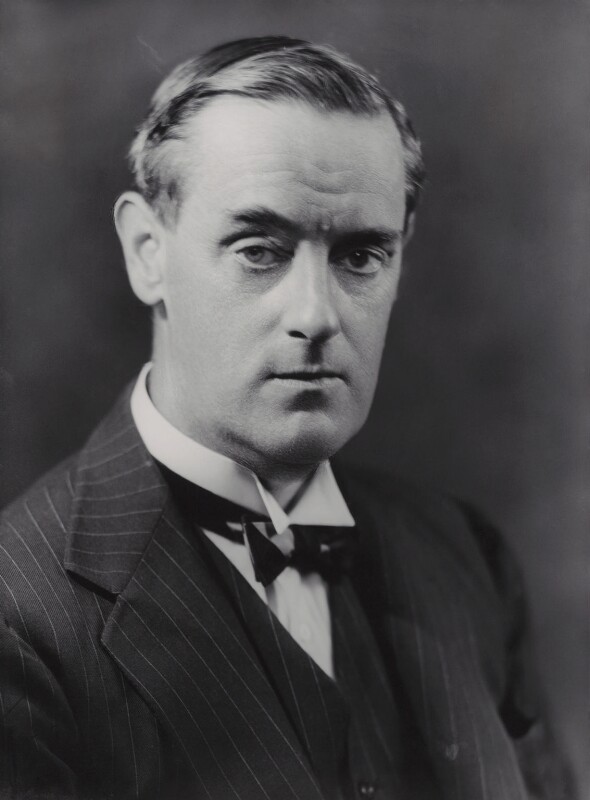
Lord Linlithgow, Viceroy of India, 1937 to 1943. / Wikipedia
Now the correspondence between Viceroy Linlithgow and Senior Maharani Tarabai Chhatrapati was a real revelation. Maharani Tarabai had already informed the Viceroy’s office that her first choice for adoption is certainly Prince Ranjitsinh Gaekwar, second son of her own brother, the Maharaja of Baroda, Pratapsinhrao Gaekwar if her daughter is not accepted as the successor to the Kolhapur throne by the British Govt. Here Viceroy Linlithgow raised objections on certain points and also suggested certain points;
1. On political and historical grounds and precedence, ruling families descended from Rajput clans in Indian India will never take it kindly if a female is chosen as the successor to the throne of Kolhapur. Particularly, Viceroy was of the opinion that Kolhapur was one of the most important princely states of India. Making a female as the heir to the Kolhapur Gaddi will create a huge hue and cry. Hence making Princess Padmaraje, the only biological daughter of Maharaja Rajaram Chhatrapati as the successor to the throne is beyond any question.
2. If the question of selecting an heir from the immediate family for adoption arises, then nobody is more suitable and qualified than the nephew of late Maharaja Rajaram Chhatrapati, who also happens to be the Maharaja of Dewas Senior, Maharaja Vikramsinhrao Puar. Maharaja Vikramsinhrao Puar also had a son. Hence if Maharaja Vikramsinhrao Puar or his son is overlooked, they should be overlooked for a candidate who is superior than them and a Bhonsle.
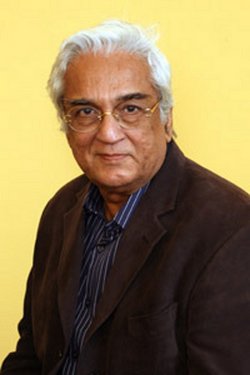 Maharaja and then then Prince Ranjitsinh Gaekwar of Baroda.
Maharaja and then then Prince Ranjitsinh Gaekwar of Baroda.
m
The point of Kagal Senior was also put up. Though in the past, adoption has happened from Kagal Senior family, but due to the disturbing behaviour from the Kagal Senior family, nobody from the Kolhapur ruling family was interested in including them again which made the Viceroy to consider Kagal Senior as out of the list.
4. Viceroy Linlithgow opined that someone from the Bhonsle clan needs to be chosen. The first thing about Bhonsle clan he observed that Khanvatkar Bhonsles had supplied heirs twice for adoption. But every time, it was observed that when the ruler from this branch reached the age of 35 years and over, he displayed symptoms of psychological derangement. Hence Khanvatkar Bhonsles cannot be considered.
5. Seeing the above set of situations and conditions, Viceroy observed and opined that the infant heir to Satara throne can be adopted and the house of Satara should be abolished and unified with house of Kolhapur. This not only increase the prestige and stature of Maharani Tarabai, but also the entire Maratha community when they will see that descendants of the founder Maratha Confederacy, Shivaji Maharaja has become a combined force. This can also be enhanced if Maharani Tarabai decides to marry off her daughter to the adoptive heir from house of Satara. And being an infant, he will easily adopt the culture and values of house of Kolhapur and his adoptive mother.
.jpg) Chhatrapati Pratapsinh Shahu Maharaj of Satara, the infant from Satara whom Lord Linlithgow first suggested.
Chhatrapati Pratapsinh Shahu Maharaj of Satara, the infant from Satara whom Lord Linlithgow first suggested.
In reply to all these arguments that was put forward by the Viceroy, a joint letter was sent by both the Maharanis of Kolhapur who put their best defence forward. Though Junior Maharani Vijaymalabai Saheb had signed, it was mainly put forward by the Senior Maharani Tarabai Sahib. Her defence was that;
1. Foremost, when the paramount power is Britain and they themselves have the history of choosing a female successor in the absence of male successor like Queen Elizabeth I and Queen Victoria, then why in progressive India, a female successor will not be recognized?
2. Maharani Tarabai wanted to know about her status in this entire adoption process. She wanted to know that will her final selection of the heir will be given the nod by His Majesty or whether His Majesty will choose the heir and Maharani Sahib will just have to give her opinion? In the latter case, then she has very few words to say.
3. Maharani Tarabai defended that as Maharaja Vikramsinhrao Puar was not a Bhonsle and a Puar, as per Hindu law, he cannot be adopted. She further elucidated that Maharaja Rajaram was never in favour of adopting his nephew Vikramsinh as his heir and she opined that her mother in law always had planned to make Maharaja Vikramsinhrao as the heir to Kolhapur throne.
4. Maharani Tarabai did agreed with Maharani Lakshmibai that both Maharaja Shahu Chhatrapati and his Maharaja Rajaram Chhatrapati disapproved of the interference from their relatives belonging to Kagal Senior Jagir.
5. Foremost, Maharani Tarabai opined since Satara and Kolhapur had separated into individual dominions for more than 200 years ago, Kolhapur has progressed much ahead than Satara in terms of status, wealth, respect and size while Satara was just confined to being a Jahagir. She said that Kolhapur had developed her own culture, identity and individuality. She also argued that the boy she will like to adopt, also should be someone that in future she might marry off her daughter to the adoptee, so that her daughter, by the virtue of marriage, can become the Maharani of Kolhapur. With the infant heir of Satara throne, she just cannot imagine seeing so. Here the infant heir of Satara was Chhatarapati Pratapsinh Shahu Bhonsle who was just few months older than Princess Padmaraje.
6. Maharani Tarabai Sahib still insisted that her nephew Prince Ranjitsinh Gaekwar is still her first choice and this choice was made, keeping in mind the welfare of her state and people as foremost, not only based on her maternal affection but like any mother, she also naturally like to see the future of her daughter secure and had plans to marry off Princess Padmaraje if Prince Ranjitsinh Gaekwar was recognised as the heir.
(1).png) Maharani Tarabai Chhatrapati with daughter Princess Padmaraje.
Maharani Tarabai Chhatrapati with daughter Princess Padmaraje.
Above all, Maharani Tarabai Sahib stated that as per Hindu laws, a wife is not only the representative of her dead husband, but also the other half of the union. She said that no question of succession arises as long as she is alive and willing to make a valid adoption. That the laws of Bombay Presidency allowed a Hindu widow to have this much individual freedom to adopt someone who she spontaneously choses to.
In August 1941, Senior Maharani Tarabai Chhatrapati and Viceroy Linlithgow met in person in Bombay to discuss the Kolhapur adoption issue. Post this discussion, the Viceroy sent an informal letter to the Maharani clearly putting his arguments forward of why he is unable to accept Prince Ranjitsinh Gaekwar as the adoptee to the Kolhapur throne. First and foremost, he stated that the decision of the Paramount Power is supreme when it comes to the recognition of the adoptee to the throne in the absence of any valid heir, natural or adopted of the late ruler. His widows can forward their choices, suggestions, recommendations if any but final decisions vests with the Paramount Power. As Maharani Tarabai was averse to making Maharaja Vikramsinhrao Puar or Kagal Senior or the Satara heir as an adoptee to the Kolhapur throne, hence Viceroy had no choice but to suggest for a boy from the Khanvatkar branch, on whom both Maharani and the Viceroy had previously agreed to overlook upon. But one thing that Viceroy Linlithgow maintained that the adoptee has to be someone from the Bhonsle clan, fit and mentally sound and presentable. Maharani’s personal plea to make her toddler daughter the successor to the throne was turned down. But he maintained that he is communicating in detail with the Maharanis of Kolhapur as it has always been a custom that the opinion of the widows of the late Maharaja was always asked for and taken into consideration when an adoptee was recognised, unanimously and from conservative point of view.
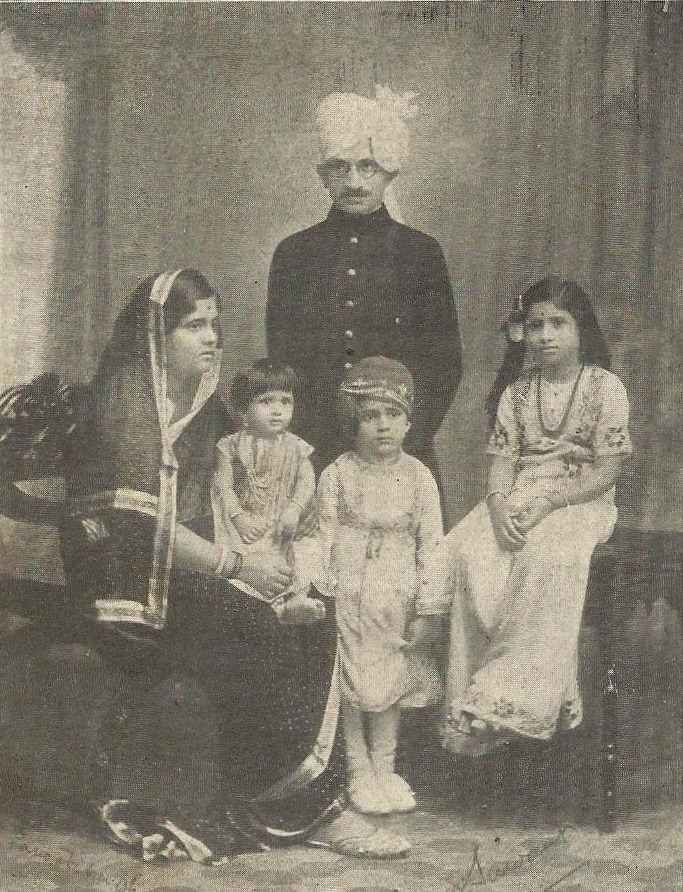
Sardesai of Sawantwadi Maharaja Shivram Sawant Bhonsle as a child seated in the center with his 2 sisters and parents including his mother the Maharani of Sawantwadi and former Princess of Baroda and sister of Snr Maharani Tarabai Chhatrapati, Parvatibai Bhonsle.
After this memoir, Maharani Tarabai wanted to send a reply about her disappointment on her proposal being rejected and also wanted to forward a new proposal. But instead of officially sending this letter, she first spoke about it with Col. Gaisford. Her new proposal was that her own sister’s son, the Sardesai of Sawantwadi, Shivram Sawant Bhonsle should be adopted. Maharani Saheb was of the opinion that Sawantwadi Bhonsles also are descendants from the same ancestors as the Kolhapur Bhonsles and also a collateral Bhonsle clan. Col. Gaisford discussed about the Sawantwadi matter with the Viceroy where Viceroy unofficially refused to accept it. Col. Gaisford also found out that Maharani Tarabai’s sister was hesitant to give off her son to the Kolhapur Gadi. Though Kolhapur and Sawantwadi shared the same Gotra, but Viceroy wanted a Bhonsle boy who was from a reasonable logical collateral Bhonsle clan, not someone very close to the paternal family of Senior Maharani.
After this meeting in Bombay, Maharani Tarabai Sahib was seriously ill and instead of returning back to Kolhapur, she stayed back at Shahu Palace in Poona where she had access to good doctors from Bombay. Now that the British Govt has made it clear to her that none of her nephews will be recognised for adoption, Col. Gaisford intimated her that already it has been nearly ten months that the throne of Kolhapur is empty and now Maharani Sahib should shortlist few boys, keep them in Poona for a week and test their suitability. Meanwhile, Maharani Tarabai selected a boy whom she has seen from birth and is a common face in Kolhapur palace, a lad of 16 years from the same gotra as the Bhonsles, studies at a convent school, good in studies and hails from a very well-connected family. His name was Ramchandra Narshingrao Ghorpade. She hoped that the British Govt cannot accuse her now of partiality and this proposal might be accepted. This proposal was declined too on the grounds of the boy’s age being 16 years.
In all these correspondences, communications, meetings, proposals and rejections, misunderstanding between Senior Maharani Tarabai Saheb and British Govt was somewhere increasing. An invisible disbalance of dissatisfaction regarding power, stature and equality, sort of tug of war was happening on the horizon in a very diplomatic way.
(3).png)
Portion of the letter written by Lord Linlithgow to MaharanI Tarabai Chhatrapati suggesting the adoption for Kolhapur throne from house of Satara, fusion of 2 houses and abolition of house of Satara.
Since August 1941, three more months passed away which also brought up the first death anniversary of late Maharaja Rajaram Chhatrapati in November. Hence, for a 1 whole year, the throne of Kolhapur was empty and the decision to finalize a suitable heir was nowhere near the horizon. Also, the date for the naming ceremony of the Baby Princess was decided to be on 24th November 1941 and it was celebrated with great pomp and splendour where many royal families, jagirdars and important people were invited. The name of the Baby Princess was kept as Padmaraje.
With the arrival of December, Maharani Tarabai Chhatrapati understood that the Viceroy Linlithgow and the Paramount Power are not interested in making any of the adoptee chosen by her as the successor to the throne. The British Govt will certainly wait for her advise and recommendation but will not give her the final power to decide. Therefore, with the help of a Kolhapur Darbar loyalist named Sir Raghunathrao Sabnis, Maharani Tarabai started investigating about the last and only remaining option, the Bhonsles of Khanvatkar branch. Khanvatkar Bhonsles again was known as 4 specific branches like Sawardekar, Chaurekar, Titwekar and the Bhonsles living around the village of Khanvat. In the previous adoptions, it was seen that male adoptees from Sawardekar and Titwekar branch developed insanity post the age of 35 years. Hence these 2 branches were abandoned. Remaining was the Chaurekar branch and the Bhonsles around Khanvat. Not much was known about the Bhonsles of Khanvat who can provide a suitable heir. On inquiring about the Chaurekar side, 4 boys were found out of which one was seven years old, another was three years old, and a young one-and-a-half-year-old was found. But what clicked was the news of the birth of another baby who was born around November 1941. The baby named Pratapsinh Nanasaheb Chaurekar was certified as a splendid baby by a British Doctor employed at the Miraj Hospital.
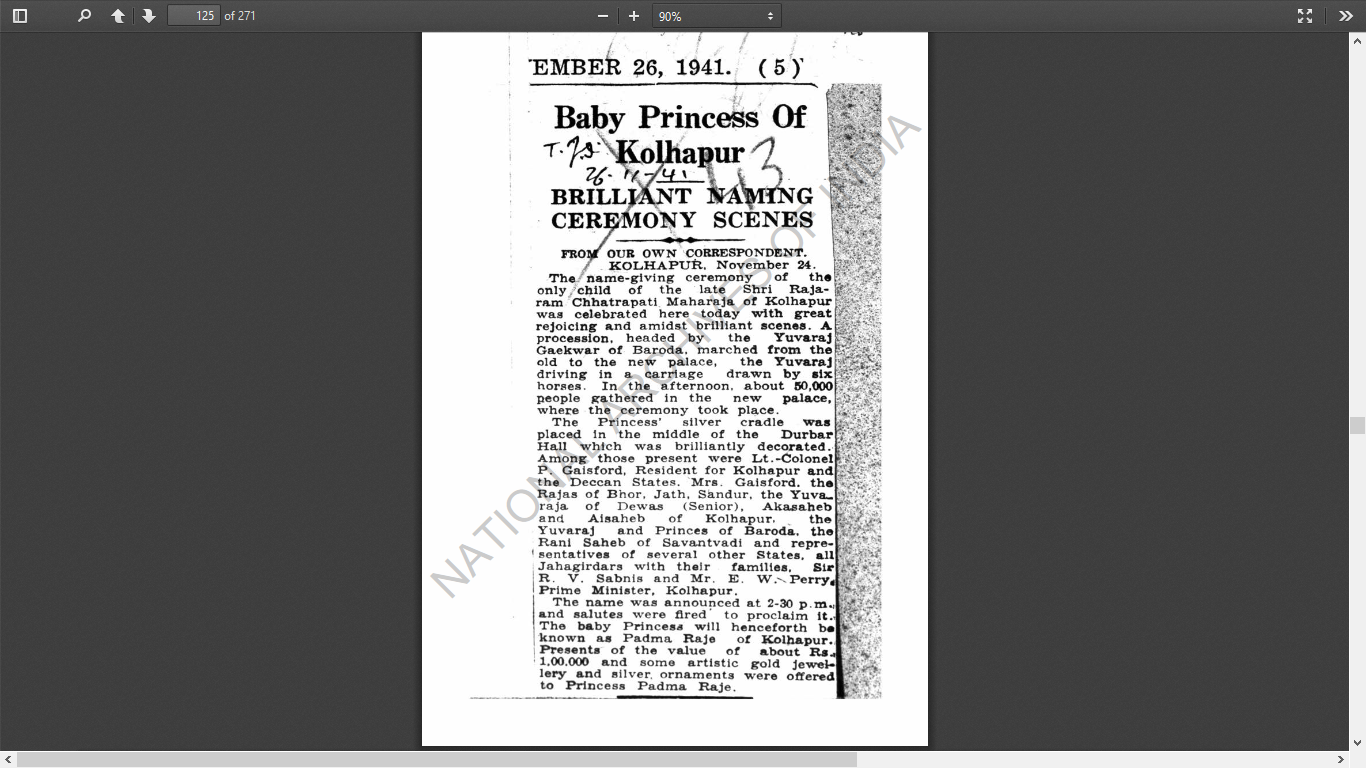
Press coverage of the naming ceremony of Princess Padmaraje Chhatrapati in 1941.
Maharani Tarabai Sahib forwarded this information to the Viceroy but at the same time expressed her dissatisfaction of being rejected multiple times when it came to the selection of the adoptee. She also expressed her doubts regarding the future of the baby, his growth, developments mental and physical, mortality rate, nutrition and hence suggested that this baby should not be considered. She insisted on considering her Baroda proposal again but also expressed that if she is again rejected, then she will have no way but to accept Pratapsinh Nanasaheb Chaurekar as the heir to throne. She also gave assurance that though her proposals were rejected multiple times by the British Govt, citing her partiality due to her personal relationships and maternal affection, but this time, due to the welfare of the state and the people, she will try to be the best mother and will give the baby all her affection.
On 31st December 1941, E W Perry, the then Prime Minister of Kolhapur announced through a press note published by the Political Dept at New Delhi that Maharani Tarabai Sahib has selected to adopt Pratapsinh Nanasaheb Chaurekar, who is from the Chaurekar collateral branch related to Sharafji, uncle of Shivaji Maharaj as the heir to the Kolhapur throne in the absence of a natural or adopted son, of late Maharaja Rajaram Chhatrapati, during his lifetime.
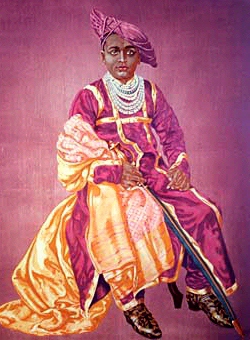
Pratapsinh Nanasaheb Chavrekar Bhonsle, heir apparent to Kolhapur throne in 1945.
But even the adoption ceremony saw drama. The biological parents of the adoptee Nanasaheb Chavrekar had disagreed to do the ceremony on the date selected by the Kolhapur Darbar which was 18th September 1942 on differences on astrological grounds. Here also the British Govt intervened and fixed the adoption ceremony again on 18th October 1942. This time, the astrologers from both the sides, Chavrekar family and Kolhapur Darbar agreed upon making Pratapsinh Nanasaheb Chavrekar as the official heir apparent to the Kolhapur throne.
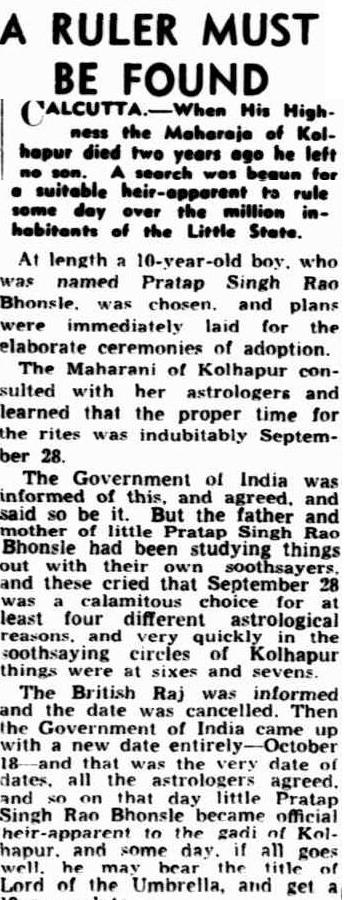
Press coverage of the drama about adoption ceremony between the biological family of the adoptee and Kolhapur Darbar in 1942.
